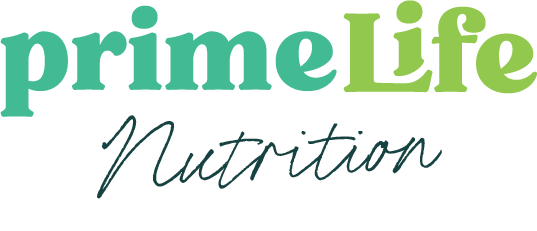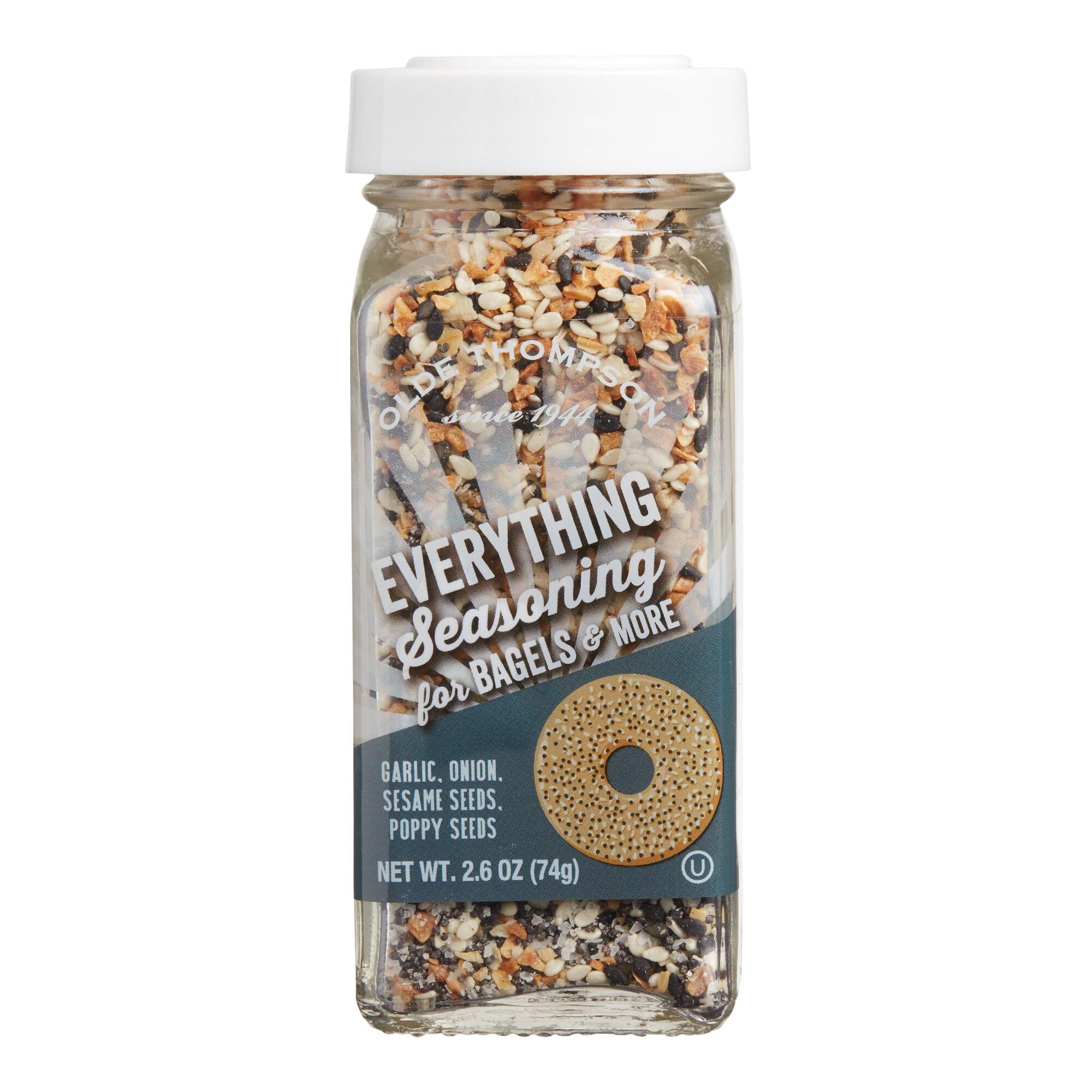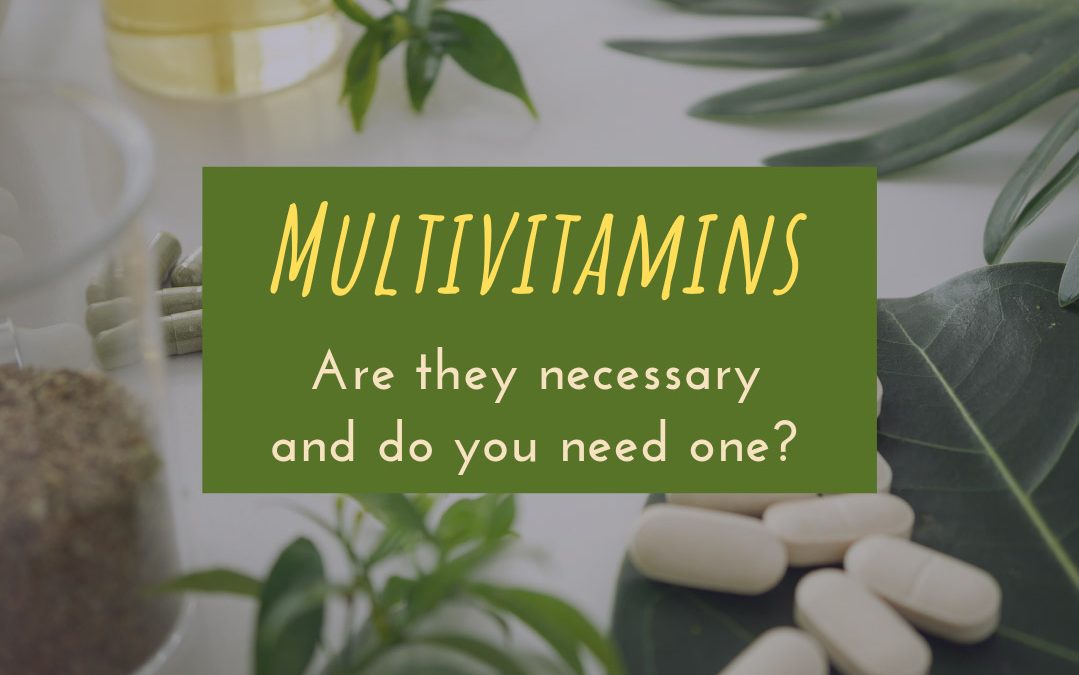
by Primelife Admin | Oct 15, 2020 | Featured, Food Science, Meal Prep
Should you be taking a multivitamin?
Before you can answer this question, you need to first take a look at your diet and any health conditions you are currently experiencing.
- Are you eating a well-rounded diet? Have you cut out any food groups?
It is important to first get your vitamins and minerals from the foods you eat. You will get more nutrition from the diversity of the foods and more fiber, phytochemicals, and antioxidants that you cannot get from supplementation. These elements of whole foods prevent diseases and improve bowel movements. However, no one person’s diet is perfect. Many people cut out certain food groups, such as dairy, for health reasons. If this is true for you, a multivitamin may be beneficial to fill in the gaps.
- Do you have a health condition that may cause you to not be able to absorb certain nutrients, or cause you to need more of a certain nutrient?
Many digestive complications such as Crohn’s disease and Inflammatory Bowel Disease can lead to malabsorption of certain nutrients. Over a period of time, nutrient deficiencies can develop and cause various symptoms. Talking to a dietitian and your doctor about your disease and possible nutrient deficiencies that may result can help you decide which vitamins you should be focusing on. Getting your vitamin and mineral levels checked can reveal if you need more than what a multivitamin can offer. If this is the case, you may be recommended to take individual supplements that have higher doses for what you need. In some situations, like being pregnant, you may need more of certain nutrients such as folic acid and iron. Pregnant women should take a prenatal vitamin.
You can never go wrong with talking to your dietitian and doctor about taking a multivitamin or a specific vitamin/mineral supplement. Explain your current diet and any health conditions you are experiencing. Above all, focusing on eating more foods in their whole and natural forms will always benefit you. You cannot overdose on nutrients when eating a balanced diet of fruits, vegetables, protein, dairy, and grains. However, you can reach a toxicity level from popping a higher dose of vitamins/minerals than you need.
Above all, if you are eating a balanced diet and are not experiencing any health conditions that require you to need more of certain nutrients, you may be better off saving your money and continuing to focus on your diet!
–Tara Greenwood Penn State University Dietetics Student
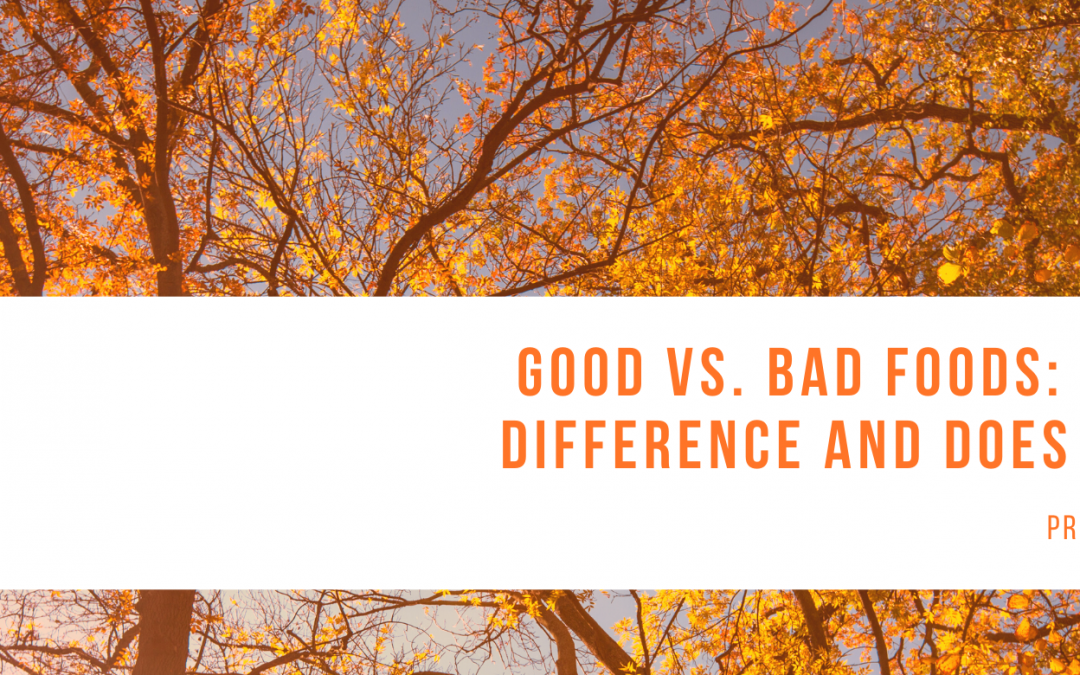
by Primelife Admin | Sep 24, 2020 | Featured, Meal Prep
I hear it ALL the time, “this food’s good for you” or “this food is bad for you”. But where do these definitions come from and why do we feel the need to place them in categories to make us feel a certain way about eating them? Defining a food as good or bad only puts the notion of how you’re going to feel after you eat a certain food. Are you going to feel good after eating a bagel and cream cheese if you consider it bad? Well, of course not if you’re defining these foods as bad. It’s time to throw away the idea that foods can be categorized as one thing or the other. It’s not about food being good or bad, it’s about what your body needs and wants and listening to it!
So let’s explore what we consider “good” and “bad”. After a fun little Facebook poll, I was able to see what you think makes a food good and bad.
Here are some answers for “good” foods:
- A food in its natural state
- Makes you feel good and does good things for you
- Grown from the Earth naturally
- Minimally processed
- You know where it’s coming from (ie; produce stand or butcher)
And here are the answers for “bad” foods:
- Makes you feel bad after you eat it
- Processed or injected with preservatives or dyes
- Fried or really heavy meals
- Foods high in sodium or fat
- Foods with a lot of ingredients or really shelf-stable
Now that we’ve identified the good and the bad, let’s throw this whole idea out and start thinking about foods differently. We need to stop villainizing foods and making ourselves feel guilty over eating certain foods. This pulls us away from listening to our bodies and eating intuitively, and closer to eating what we think we should eat rather than what we want to eat.
In order to allow ourselves to stop categorizing foods, you need to start thinking about the foods you genuinely enjoy and how to incorporate them into your day to day. If you love mac and cheese (like me), it shouldn’t be something that you’re afraid to eat or only eat on special occasions. It should be a food that you have when you want it, and get satisfaction from. Allowing yourself to enjoy the foods you love can help limit the feeling of needing to over eat that food. The more you restrict, the more you want it; so why deprive yourself? Every fad diet out there will give you a list of “no” foods and a list of “yes” foods. All this does is reinforce the categorizing of good and bad foods.
We give food way too much power than it deserves. We allow it to adjust our social life, make us feel restricted, and sometimes even affect the relationships we have with others. If you want to stop feeling so powerless towards dieting, you have to take the power for yourself. Stop being afraid of foods and start loving foods. Be comfortable, happy and confident with the choices you make. The more intuition you put into eating, the more empowered you feel and the more you’ll want to eat foods that make you feel better as a whole.
Eating intuitively takes time, patience, and lots of rewiring our brains. Working with a Registered Dietitian can help you plan, strategize, and ensure you’re not overwhelmed with changing the way you see foods. Just remember that no one food is going to sabotage your hard work and the less stress you put on yourself, the easier the transition will be.

by Primelife Admin | Jun 24, 2020 | Food Science, Meal Prep
That first smell of a grill sparking up and searing meats or vegetables is one of the most inviting smells of summer. Not only is your grill an awesome outdoor cooking method, but it’s also a great party-friendly way to cook a ton of delicious food! Since we’re mid-grill season, I wanted to share some great tips and tricks to make the most of your grilling experience.
So why can grilling your food be a better option than other cooking methods? Flavor, time, and efficiency are three of the most obvious reasons. Take grilled chicken versus baked chicken; the grilled chicken is going to have a more charred and smoky flavor without adding more calories or sauces to it than a baked chicken in the oven. This is the case with pretty much every meat; steak, sausages, hot dogs, burgers, etc. Not only is the flavor deliciously enhanced in a grill, but the time you need to cook the food lowers as well. Again, baking any meat can take anywhere from 25-40 mins, but cooking a burger or dog on a grill takes a mere 10 minutes! Not to mention, who wants to heat up the house in the middle of summer with an oven when you can grill outside.
In addition to efficiency, the amount of food you can grill at one time increases as well. Grills typically have more surface area to cook food than an oven will. Of course it depends on what you’re making, but you’re typically going to cook more at one time on the grill than in the oven. We love to save time, so why not use the grill to help you?
Are there any foods that you’ve always wanted to grill, but never knew if it could happen? I have personally been experimenting with different foods to see what works and what doesn’t. Wings, pizza, vegetables, onion, pineapple, and watermelon are a few of the foods I’ve tried lately and let me tell you, they’ve all come out delicious.
Some other foods you can grill that you may not have realized include eggs (cooked in a cast iron skillet), bacon, meatloaf, lasagna, avocados, peaches, and bananas. I don’t know about you, but this makes me want to get creative! Anywhere from savory to sweet can work on your grill, it’s all about using the right tools and trying something new.
Who doesn’t love a good hack when they see one? Some grilling hacks that I hope can make your grilling experience easier are below.
- Using grill mats to keep foods cleaner and falling through grates.
- Brushing ½ an onion on your grill grate to prevent sticking.
- Grilling corn on the cob in the husk for maximum flavor and steaming, cutting off and squeezing out the corn while it’s still warm. It’ll keep the silk from sticking too!
- Always soak your skewers in water for 10-20 minutes before using to prevent burning.
- When grilling fish, leave the skin on for more flavor and nutrient value (vitamin E, D, Iodine, Selenium, and healthy fats).
- Using tin foil to make “packs” and combo dishes.
- Cheesy vegetable packets
- Mixed chicken and vegetable packets
- Loaded “smashed” potato packets
- Banana, chocolate and marshmallow packets
- Smore’s packets
These are just a very few examples of recipes and foods you can make on the grill. If you’re not a big grill person, I hope this helps give you ideas and new ways to start utilizing it. I myself was always timid of the flames and heat, but it’s such a great way to kick off summer, and even use it all throughout the year! Check out my personal recipe for delicious turkey meatball skewers to make for your family, or for your next party. Have a wonderful summer!

by Primelife Admin | Mar 31, 2020 | Featured, Meal Prep
Before I was a believer, I always thought Costco was all hype; until I started to drink the kool aide myself. I can now say that I love everything “Costco” and go grocery shopping there EVERY WEEK. Granted, there are only 2 of us in the house, but I still manage to get almost ALL foods I need from Costco, and it keeps my meal prep simple and food waste down. Check out some of my favorite items I have on hand to keep my week consistent and stay on track.
- Hummus cups – These little individually packed hummus cups make snacks and lunches much easier. Coming in at 160 calories per cup, paired with carrots or celery make the perfect, satisfying snack. You could also incorporate it in lunches by spreading it on wraps and sandwiches. Want a little spice? You could add some sriracha or hot sauce to kick it up a notch!
- Salsa – Being a dietitian, I always stress how taco salads are so satisfying, yet so low calorie! Using salsa as your dressing dramatically cuts down on saturated fat and sugar intake compared to traditional salad dressings. Not into salads? Just have it as a snack! Having chips and salsa already portioned out into containers will keep your week simple yet still satisfying.
- Salad kits – Prepping a salad takes a lot more work than it does to prep a sandwich or wrap. Costco has huge salad kits that will feed you at least 4 times during the week. What I’ll do is take the lettuce from the kits and divide into four containers, throw the salad mixings in snack baggies divided into four (so they don’t get soggy), and pick out a dressing. The beauty of this is you don’t need to buy all the ingredients individually, just pair with a protein and you’re done! Meal prep in less than 10 minutes! My favorite mix to use is the Greek salad kit with added chickpeas for protein (1/2 cup per salad).
- Beans – Yes, the magical fruit. They’re loaded in fiber, protein, B vitamins, potassium, and the list goes on. The best part about getting them at Costco? You can get 6 cans in one shot and they’ll last you for weeks! As I mentioned earlier, adding beans to salads, dips, sandwiches and snacks is the easiest way to boost protein as well as kick up the fullness factor. No cooking is involved and your time is saved by using canned beans. Just be sure to rinse them before adding them, as it will wash off a lot of the sodium beans can have.
- Frozen cauliflower pizza – This pizza is one of my favorites to ALWAYS have in my freezer. It has saved me from going out to eat countless times and I’m just as satisfied, maybe even more satisfied than if I were to go out and grab a pizza. Are they pricey? Yes, but you’re paying about $7 for each pizza which if you were to go out to eat, you’d be paying double that. It tastes delicious, is only 250 calories for a serving, and you can pick it up with your hands to eat it! #winning
- Bean and rice burritos/burrito bowls – These are another super satisfying, yet quick grab and go type food. They are frozen, so they can hang out in your freezer until you come across that one time where you don’t have a plan, you’re hangry, and you have nothing to eat in the house. I have eaten these so many times when I just don’t have time to sit down and eat and I need to make it quick. Not only are they delicious and super easy to throw together, they’re also vegetarian!
- Eggs – If you asked me a few years ago if I thought hard-boiling 28 eggs was aggressive, I would’ve told you you’re right. What I’ve come to realize, is that 28 eggs can go fast when you’re using them either in a meal or as a snack between 2 people. These eggs are sold in a 28-pack, which is perfect for me because I know I’ll use them all! I cook them all in the oven to keep meal prep simple, and they come out tasting fresh, delicious, and easy to peel which is always a win.
- Veggie Cakes – Are they processed? Yep! Does that stop me from buying them? Nope! These veggie cakes are a great way to add veggies to a protein to make your meal complete. We all have those nights where dinner isn’t prepared, and we don’t feel like cooking. These cakes come in handy especially for that! They’re loaded with veggies, provide some protein, and you can try to trick your kids into eating them too! Yes, it’d be better to make these on your own, but who always has time for that?
- Quinoa – This bag just keeps on giving. I’ve gone through 2 of these in 2 years time. I would consider this a panty staple for sure. When you’re low on time or don’t have a starch to pair with meals, quinoa will always be there waiting when you have a 4 ½ lb bag in your cupboard. One of my tricks to adding more flavor? Cook it in a broth instead of water (bone broth, chicken broth, vegetable broth) and it’ll shock your tastebuds!
- Rotisserie chicken – The meat that’s already cooked and tastes delicious before you even take it home. These can be great for a quick family dinner paired with some veggies or even a salad kit from Costco and you have a complete meal. Also, they’re only $5, I mean….do I need to say more?
While I have listed my top 10 foods that I get, I have to say that Costco always surprises me. Since I made this list, I’ve also tried egg white frittatas (delish), chickpea snacks, raw nuts, beyond meat cauliflower pizza, almond milk, mashed cauliflower, and the list goes on. I can’t say enough great things about the healthy options I find here, it’s just a matter of looking around and seeing what’s new. That’s another thing I love about this big-box store; there’s always something new to try! So next time you have an hour to burn, stop by your local Costco, check out the food items and let me know if you find something new and delicious!
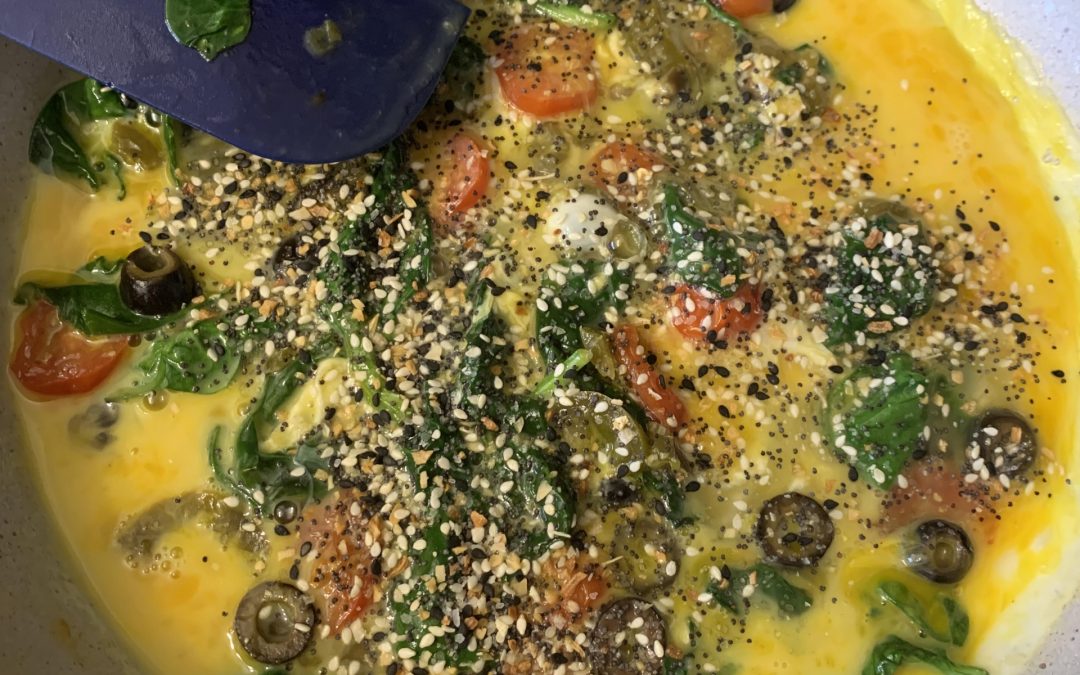
by Primelife Admin | Jan 28, 2020 | Featured, Food Science, Meal Prep, News
Everything bagel seasoning has emerged as the latest thing to literally put on everything. So why not provide you with some knowledge on why it can be great for you and how you can use it more often! It all started with a grocery store called Trader Joe’s. They came out with a little bottle of magic called “Everything but the bagel” seasoning, and it sounds exactly like it is…everything but the bagel.
It’s simply the seasoning that you find on an everything bagel, but guess what….it’s good on everything!!
It’s comprised of sesame seeds, poppy seeds, dried onion flakes, dried garlic flakes, and sea salt. All these flavors formed into one make a super seasoning! So why should we use it on foods? The poppy and sesame seeds are going to offer up more healthy fats (omega-3s), offer more satiety in meals, and of course load it up with flavor. Calories are moderately low, so this seasoning is a great choice to add a burst of flavor. A serving size is considered ¼ tsp which offers up a whopping 5 calories, so while it still provides calories, it’s not going to load calories onto a meal like a sauce or marinade would. You do still have to be aware of the sodium, since sea salt is one of the ingredients, but as a whole, this can be a great choice on lots of different foods.
If you haven’t tried “everything” seasoning yet, here are a couple of foods you could try it with to see if you truly like it. I’ve personally thrown it onto my eggs (which is amazing), coated chicken and steak with it, added it to roasted veggies, and you could also add it to a soup, salad or avocado toast as well! There are SO many ways you can use this seasoning that it’s almost silly not to try it.
Finding this seasoning used to be much harder, but with the popularity of it growing, it’s easier to find. Some big stores you can find it in include Walmart, Costco,Giant, Redner’s and of course the OG Trader Joe’s. If you don’t feel like buying it, chances are you have all the ingredients to make it at home too!
- 1/4 cup sesame seeds
- 1/4 cup cups poppy seeds
- 3 tbsp tbsp dried onion flakes
- 3 tbsp dried garlic flakes
- 2 tbsp course sea salt
Mix all this together and you’ll get 1 cup of deliciousness! Time to take your meals up a notch!

